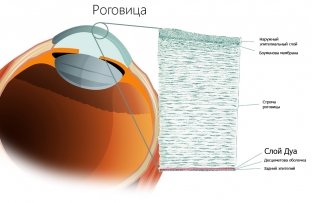Scientists at the University of Nottingham, UK, have discovered the sixth layer of the human cornea. They published the results of their discovery in the journal Ophthalmology.
The study was carried out on the corneas of the eyes, which were donated to the organ bank in Bristol and Manchester for experimental purposes. Using small balloons of air that the scientists launched to separate the layers of the cornea, they isolated a new layer, named after the discoverer Harminder Dua – "Dua".
During the study of the cornea of the eye, each layer (epithelium, Bowman's layer, stroma, Descemet's membrane and endothelium) was carefully examined under an electron microscope. As a result, a new layer of the back of the cornea was found, located in the anterior part of the human eye between the Descemet's membrane and the corneal stroma. The formation is very hard and thin, only 15 microns thick.
This discovery will help bring modern ophthalmology to a new level and open up new opportunities for surgeons in the field of corneal tissue transplantation: the operation will become easier and less dangerous. Thanks to the examination, during the operation, surgeons will be able to easily determine in which layer of the cornea the bubbles are collected in order to avoid damage.
Professor Dua noted that in connection with the new discovery, there is a need to change the information in all ophthalmological textbooks, as well as books that describe the structure of the eye.
Over 66,000 operations on the cornea of the eye are performed annually in the world. New knowledge will allow doctors to perform interventions with less risk of possible complications (eg bleeding), thereby increasing the chance of saving human eyes.
In addition, scientists have suggested that dropsy of the eye is provoked by the accumulation of water through a gap in the Dua layer. In the future, this discovery will help fight many eye diseases.







Add a comment